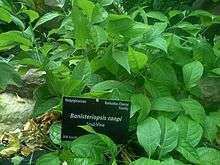Banisteriopsis caapi
| Banisteriopsis caapi | |
|---|---|
 | |
| Young B. caapi | |
| Scientific classification | |
| Kingdom: | Plantae |
| Clade: | Angiosperms |
| Clade: | Eudicots |
| Clade: | Rosids |
| Order: | Malpighiales |
| Family: | Malpighiaceae |
| Genus: | Banisteriopsis |
| Species: | B. caapi |
| Binomial name | |
| Banisteriopsis caapi | |
Banisteriopsis caapi, also known as ayahuasca, caapi or yagé, is a South American liana of the family Malpighiaceae. It is used to prepare ayahuasca, a decoction with a long history of its entheogenic use and its status as a "plant teacher" among the indigenous peoples of the Amazon rainforest. It contains the harmala alkaloids harmine, harmaline, and tetrahydroharmine. These alkaloids of the beta-carboline class act as monoamine oxidase inhibitor (MAOIs). The MAOIs allow the primary psychoactive compound, DMT, which is introduced from the other main ingredient in ayahausca Psychotria viridis, to be orally active. The stems contain 0.11–0.83% beta-carbolines, with harmine and tetrahydroharmine as the major components.[2] Alkaloids are present in all parts of the plant.[3]
According to The CRC World Dictionary of Plant Names by Umberto Quattrocchi, the naming of the genus Banisteriopsis was dedicated to John Banister, a 17th-century English clergyman and naturalist. An earlier name for the genus was Banisteria and the plant is sometimes referred to as Banisteria caapi.
Legal issues
Legality
In the United States, caapi is not specifically regulated. A 2006 Supreme Court decision involving caapi-containing ayahuasca, which also contains other plants containing the controlled substance DMT, introduced from the Psychotria viridis component, Gonzales v. O Centro Espirita Beneficente Uniao do Vegetal, was found in favor of the União do Vegetal, a Brazilian religious sect using the tea in their ceremonies and having around 130 members in the United States.
In Australia, the harmala alkaloids are scheduled substances, including harmine and harmaline; however, the living vine, or other source plants are not scheduled in most states. In the State of Queensland as of March 2008,[4] this distinction is now uncertain. In all states, the dried herb may or may not be considered a scheduled substance, dependent on court rulings.
In Canada, harmala is listed under the Controlled Drugs and Substances Act as a schedule III substance. The vine and the ayahuasca brew are legal ambiguities, since nowhere in the Controlled Drugs and Substances Act is it stated that natural material containing a scheduled substance is illegal, a position supported by the United Nations International Narcotics Control Board.[5]
Caapi, as well as a range of harmala alkaloids, were recently scheduled in France, following a court victory by the Santo Daime religious sect allowing use of the tea due to it not being a chemical extraction and the fact that the plants used were not scheduled. Religious exceptions to narcotics laws are not allowed under French law, effectively making any use or possession of the tea illegal.
Patent issues
The caapi vine itself was the subject of a dispute between U.S. entrepreneur Loren Miller and the Coordinating Body of Indigenous Organizations of the Amazon Basin (COICA). In 1986, Miller obtained a U.S. patent on a variety of B. caapi.[6] COICA argued the patent was invalid because Miller's variety had been previously described in the University of Michigan Herbarium, and was therefore neither new nor distinct.[7] The patent was overturned in 1999; however, in 2001, the United States Patent Office reinstated the patent because the law at the time the patent was granted did not allow a third party such as COICA standing to object. The Miller patent expired in 2003. B. caapi is now being cultivated commercially in Hawaii.
Alkaloids
Cultural references
The 2011 novel Plant Teacher explores how the use of caapi transforms the life of one narcotourist.[8]
See also
References
- ↑ "Banisteriopsis caapi". Germplasm Resources Information Network (GRIN). Agricultural Research Service (ARS), United States Department of Agriculture (USDA). Retrieved 15 December 2017.
- 1 2 3 4 Callaway, J. C.; Brito, Glacus S.; Neves, Edison S. (June 2005). "Phytochemical analyses of Banisteriopsis caapi and Psychotria viridis". Journal of Psychoactive Drugs. 37 (2): 145–150. doi:10.1080/02791072.2005.10399795. PMID 16149327.

- ↑ Ayahuasca: alkaloids, plants & analogs
- ↑ "Archived copy" (PDF). Archived from the original (PDF) on 2008-08-06. Retrieved 2008-08-26.
- ↑ International control of the preparation "ayahuasca", letter from the United Nations International Narcotics Control Board
- ↑ U.S. Patent PP5,751
- ↑ "Situation of the patent for Ayahuasca". 7 July 2003. Archived from the original on 21 April 2011. Retrieved 10 June 2011.
- ↑ Alethia, Caroline (2011). Plant Teacher. United States: Viator. ISBN 1468138391.
Further reading
- Barbosa, PC; Cazorla, IM; Giglio, JS; Strassman, R (September 2009). "A six-month prospective evaluation of personality traits, psychiatric symptoms and quality of life in ayahuasca-naïve subjects". Journal of Psychoactive Drugs. 41 (3): 205–12. doi:10.1080/02791072.2009.10400530. PMID 19999673.